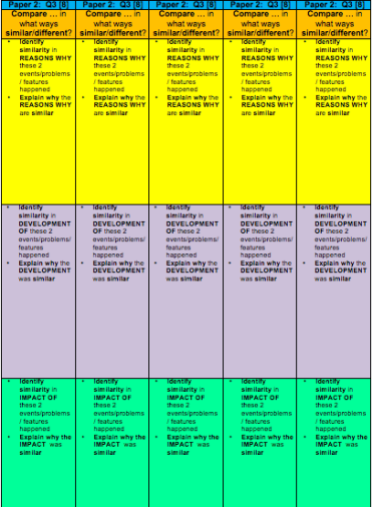
(Glenn posted the original version of Structure Strips on his History Tech site several months ago. He loves the idea of Structure Strips so much, he’s sharing it with us here at Doing Social Studies. Enjoy!)
Over the last few months, I’ve had the chance to be part of several teacher conversations focused on the integration of social studies and literacy. And for the last few years, I’ve had the chance to work with the Kansas Department of Education and Kansas teachers as we rolled out our revised state standards and assessments – both of which concentrate on finding ways for kids to read, write, and communicate in the discipline.
So while I am not some super duper ELA expert, I did think that I knew a little something about literacy tools. But I recently got a great wake-up call that let me know that there is always something new to learn.
I was doing some internet browsing for literacy activities and ran across references to something I had never heard of before. And it looks like an awesome tool to slip into your bag of tricks.
Structure strips.
 Structure strips are a simple but powerful scaffolding tool to help kids focus on organizing their thinking and written responses to prompts. They apparently started at the elementary level but can easily be adapted to work with middle and high school students.
Structure strips are a simple but powerful scaffolding tool to help kids focus on organizing their thinking and written responses to prompts. They apparently started at the elementary level but can easily be adapted to work with middle and high school students.
They seemed to have been originally developed by grade school guru Stephen Lockyer (@mrlockyer) and then shared extensively by Caroline Spalding (@MrsSpalding), with a special focus on ELA.
The size of a large bookmark, structure strips are glued along the edge of piece of paper or interactive notebook. Each strip has specific divisions with each area representing a paragraph of the writing response.
Each division contains information and examples of what each paragraph should contain. Some examples even suggest that the amount of space in that area represents how long that paragraph should be. A body paragraph might be longer that an introductory paragraph for example.
So with the structure strip glued or taped along the edge, your kids can now respond to your prompt with the strip as a guiding scaffold.
Some things to think about:
- These would be great for the next few months at the start of school. Use them as a scaffold, as a way to model thinking and writing, to help your students at the beginning of the year.
- Have students create their own strips as the year goes on. Perhaps have kids exchange strips that they create to see other possibilities.
- Create different strips for different types of writing prompts. The expository strip will be different than the argumentative strip.
- Copy the strips on bright paper to help them stand out more when glued own.
- Use structure strips as a way for kids to do self and peer assessments.
You can find a packet of sample structure strips like the one below at the TES site.

A few more examples:

And I know that you could do something similar to this in Google Docs or Keep or Padlet or any number of different digital tools. If you’re into the tech, I’m okay with that. But I’m kind of liking the paper / glue thing going on here. Either way, you’re modeling for kids and helping them organize their thinking process and supporting quality product creation.
So adapt away. Arrange your strips in whatever way makes the most sense for your grade and content. Maybe use the SHEG historical thinking chart. Or use primary source analysis worksheets from the Library of Congress or National Archives.
And a little plug for the founder of the feast – @mrlockyer has lots of other great ideas and suggestions in his book 100 Ideas for Primary School Teachers. Head over to get more info and to purchase for your own use.
